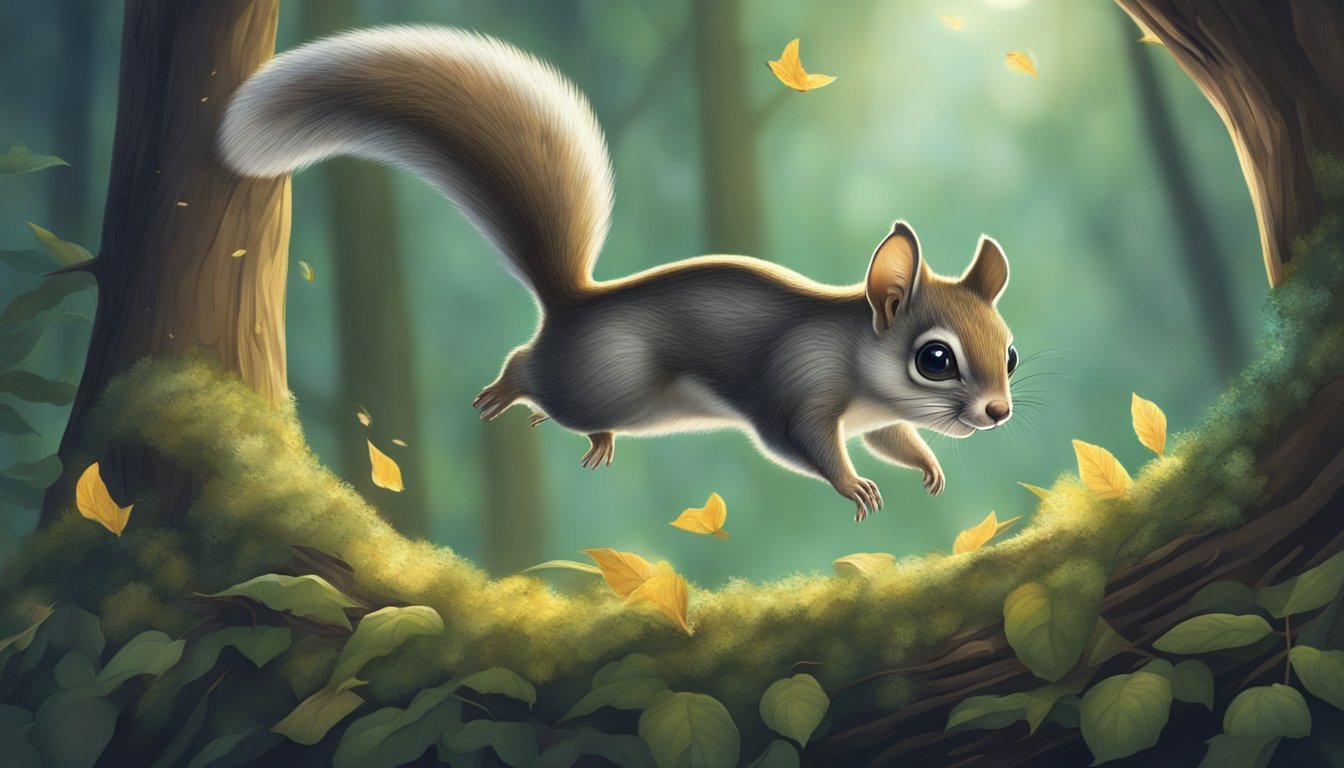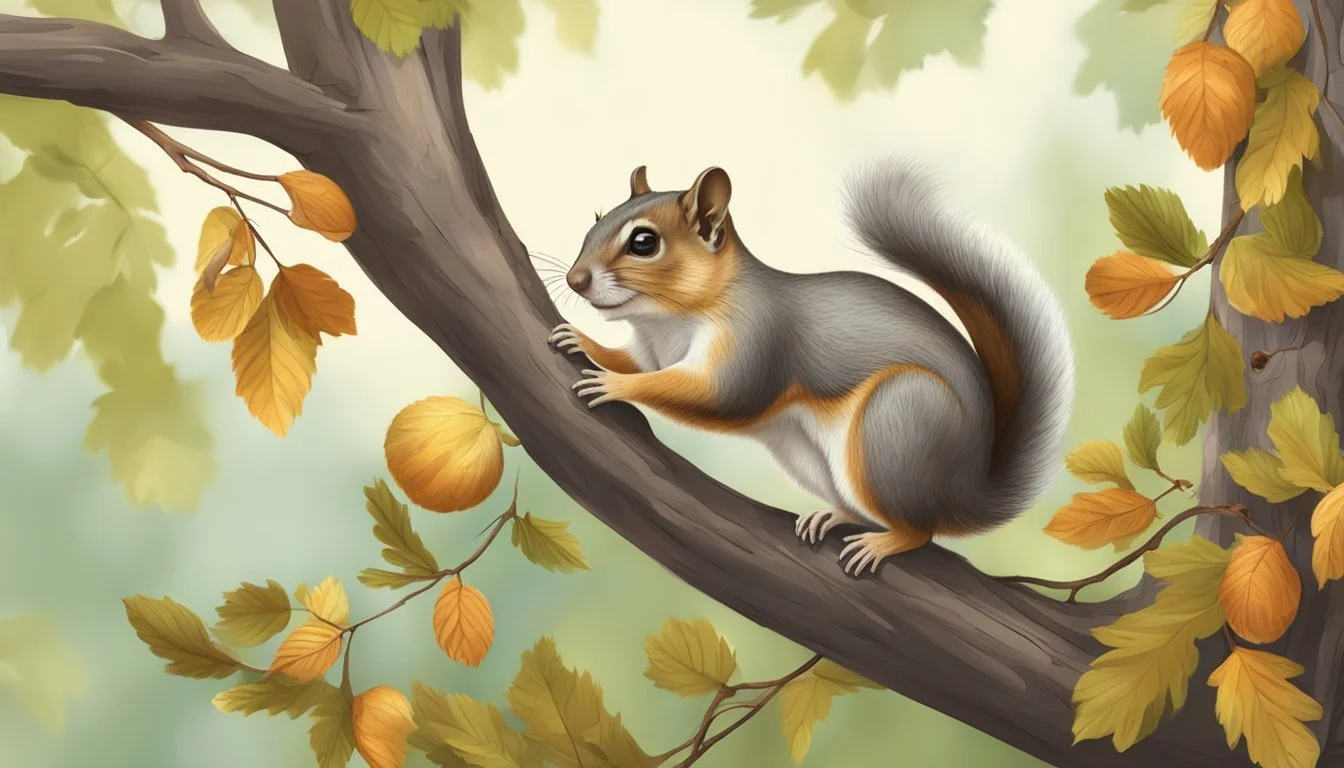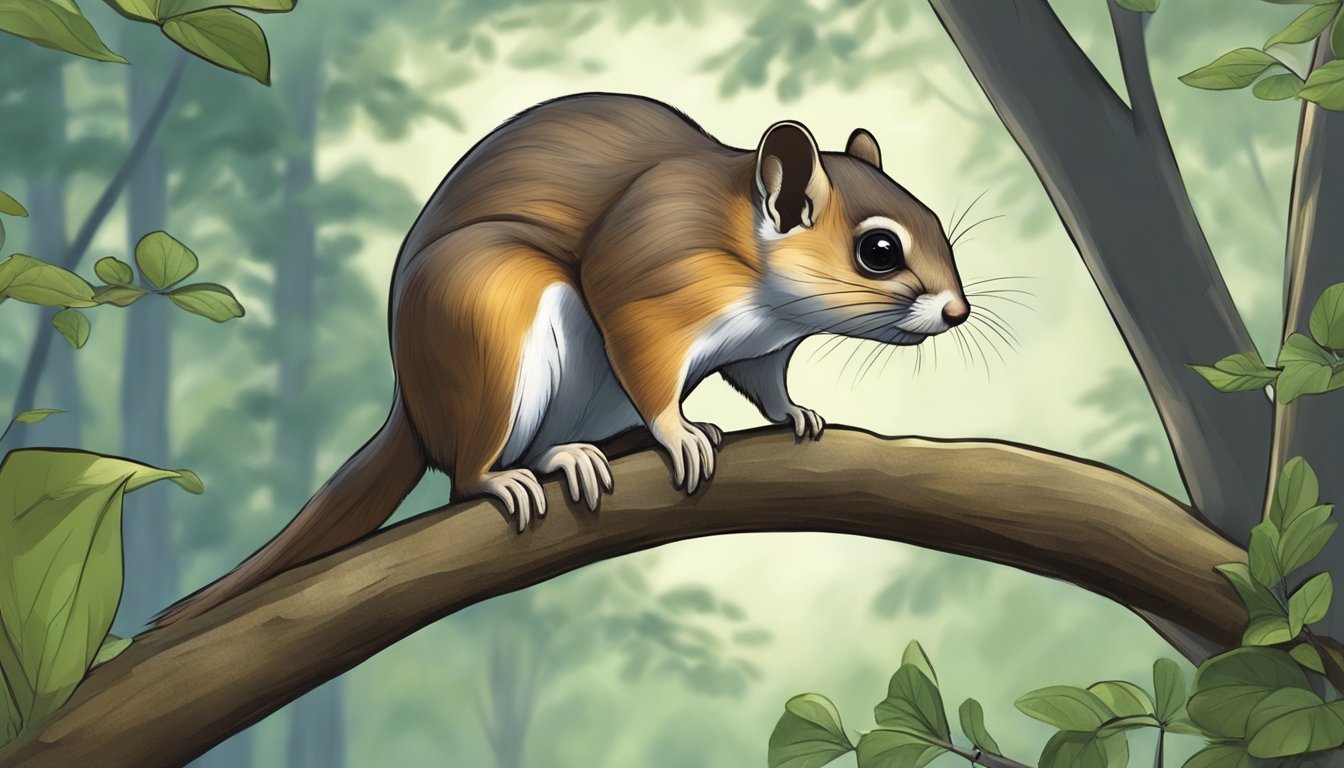Flying Squirrel Hunting Seasons
Regulations and Timeframes
This Article is Part of Our Guide on Hunting Seasons for Over 70 Common Game Species
Hunting seasons for flying squirrels vary by state, with regulations set to ensure the sustainable management of these nocturnal creatures. Flying squirrels, including the southern flying squirrel found in vast deciduous forests, are smaller than their non-gliding counterparts and are known for their unique method of travel. They glide from tree to tree with the aid of a patagium, a membrane stretching between their limbs, and their nocturnal habits make them a less common target for hunters.
In many regions, the hunting season for squirrels coincides with the presence of mature nuts (how long do nuts last?) and fruits that these animals rely on for food. For instance, in Virginia, squirrel hunting is permitted from September to February, a time frame that is typical in many other states as well. During these periods, hunters must adhere to the specific bag limits and hunting regulations designed to prevent overharvesting and to ensure the species' long-term viability amidst their natural habitat.
Overview of Flying Squirrel Species
Flying squirrels are a distinctive group of squirrels known for their gliding ability, differentiating them from other squirrel species, such as the red squirrel and gray squirrel. These remarkable creatures have adapted to their arboreal lifestyle with unique physical characteristics and inhabit various forests around the world.
Characteristics of Flying Squirrels
Flying squirrels possess a membrane called the patagium, which stretches between their limbs and allows them to glide through the air. Unlike the red squirrel and gray squirrel, which bound across the terrain, flying squirrels can cover distances up to 90 meters (300 feet) by steering and controlling their glide using their limbs and tail. They have large eyes that are well-adapted for their nocturnal lifestyle, aiding them in navigating the treetops at night.
The body size of flying squirrels varies. For example, the southern flying squirrel might measure from 8 1/2 inches to 9 7/8 inches, including a 3- to 4-inch-long tail, and weighs no more than 2 or 3 oz. Their fur tends to be soft and can range from lustrous light brown to other colors, depending on the species.
Habitat and Distribution
Flying squirrels are found primarily in wooded areas. They are forest dwellers and depend heavily on trees for shelter and food. Species such as the southern flying squirrel predominantly reside in the temperate and tropical forests of India and other parts of Asia, as well as in North America. Their distribution spans across various regions, from the cold northern Eurasian forests to the warmer Southern states of the U.S.
They are classified into more than 50 species, with distinct habitats ranging from the northern flying squirrel typically found in North American coniferous forests to those inhabiting the dense canopies of Asian tropical forests. The availability of food sources, including seeds, nuts, fungi, fruit, and insects, plays a crucial role in their habitat preference. Some species such as the southern flying squirrel are also known to consume animal-based food like eggs, birds, and carrion, making their diet one of the most carnivorous among their peers.
Legal Framework for Hunting
In the United States, hunting flying squirrels is subject to strict regulatory guidelines and licensing requirements to ensure both the conservation of wildlife and the safety of participants.
Hunting Regulations and Laws
Regulations: Each state enforces its own set of hunting regulations, which are designed to manage wildlife resources sustainably. For instance, it is illegal to hunt flying squirrels in some regions because they are often protected due to their lower population numbers compared to other squirrel species like the gray, fox, and red squirrels.
Seasons: State-specific hunting seasons determine when hunters can pursue certain animals, including squirrels. These seasons are usually set around the breeding cycles of the species, to avoid impacting their populations adversely.
Bag Limits: Bag limits are imposed to prevent overharassment of species. These limits stipulate the maximum number of animals that an individual may harvest in a day or season.
Licensing and Education Requirements
Hunting License: Hunters are required to obtain a hunting license from their respective state conservation or wildlife management agency. Licenses can vary by age, residency status, and the type of game being hunted. For example, some states may offer a junior hunting period where young hunters can hunt without a license within certain constraints.
Education: Before obtaining a license, hunters may be required to complete a hunter education program. These programs cover topics such as wildlife management, hunting laws, ethics, and firearm safety.
Permits: In addition to a hunting license, some states may require specific permits for hunting certain animals, especially if they are considered protected or endangered species.
Hunting Seasons and Limits
Hunting seasons and limits are critical aspects of wildlife management and conservation. They help maintain balance in ecosystems, ensuring that the populations of flying squirrels remain sustainable.
Seasonal Timing and Restrictions
Flying squirrel hunting seasons are established by wildlife management agencies and can vary greatly based on geographic location. In some areas, these seasons align with those of other small game, whereas in others, they might be subject to more strict regulations due to the nocturnal and less visible nature of flying squirrels. State-specific regulations must be thoroughly reviewed to understand the permitted hunting dates, as well as any additional restrictions that may apply.
It's important to note that in some states, like Pennsylvania, certain wildlife can be hunted on select Sundays, offering more opportunities for hunters.
Bag and Possession Limits
The bag limit refers to the number of flying squirrels a hunter can legally harvest in a single day, while the possession limit pertains to the total number a hunter can have at one time. These limits are put into place to prevent overharvesting and ensure a sustainable population of the species.
Bag Limit: Often set to a specific number per day to prevent excessive harvest of flying squirrels.
Possession Limit: May be a multiple of the daily bag limit and accounts for potential harvests over several days of hunting.
Strict adherence to bag and possession limits is crucial for conservation efforts and to support the health of flying squirrel populations and their habitats. Compliance with these regulations is also a legal requirement and is essential for the continuation of hunting as a sustainable practice.
Hunting Preparation
In preparing for a successful flying squirrel hunting season, one must consider the importance of appropriate equipment and mastery of scouting and tracking techniques. These factors significantly influence a hunter's success in the field.
Equipment and Gear
Camouflage: A hunter must wear suitable camouflage since flying squirrels can detect movement and silhouettes. The patterns should match the forest environment to reduce visibility.
Weaponry: Depending on local regulations, a hunter may use a rifle or shotgun. A .22 caliber rifle is often chosen for its precision, while a shotgun with #6 shot is favored due to its wider spread.
Binoculars: These are crucial for spotting flying squirrels in dense canopies. Quality binoculars with night vision capabilities are recommended due to the nocturnal nature of flying squirrels.
Boots: Durable boots with good ankle support ensure stability across uneven forest terrains.
Knife: A multi-purpose knife is essential for skinning the squirrel and other tasks in the field.
Scouting and Tracking Techniques
Habitat Knowledge: Hunters should familiarize themselves with the preferred habitats of flying squirrels, such as areas with dense canopies and abundant nut-bearing trees.
Scouting: Prior reconnaissance of the hunting grounds is vital. A hunter must look for signs like droppings, chewed nuts, and nesting sites.
Tracking: Understanding flying squirrel behavior, such as their gliding patterns and feeding times, is key to effectively tracking them.
By meticulously choosing their gear and honing their scouting and tracking skills, hunters can increase their proficiency in harvesting flying squirrels during the designated hunting seasons.
Hunting Methods and Strategies
In the pursuit of flying squirrels, hunters employ a diverse set of methods and strategies tailored to these nocturnal creatures. Optimal tactics depend on whether one hunts during daylight or nighttime, and each method requires different preparations and equipment to maximize effectiveness.
Daytime and Nighttime Strategies
During the day, flying squirrels are typically inactive, but hunters can use this time to scout for nests and feeding areas. Hunters might engage in still hunting, where they quietly wait in areas flying squirrels are known to frequent. While less common due to the nocturnal nature of flying squirrels, daytime hunting does benefit from increased visibility.
Conversely, the night offers prime activity hours for flying squirrels. Utilizing a spotlight or headlamp can aid in locating these creatures. Hunters often listen for the distinct sounds of flying squirrels gliding or moving about in the treetops. Moreover, employing electronic calling devices that mimic squirrel sounds can be particularly effective in drawing them out during nocturnal hunts.
Baiting and Attracting Squirrels
To attract flying squirrels, baiting is a common technique. Hunters often use a variety of foods like nuts or seeds, which can be placed in a bait station to draw squirrels into range. It's crucial to place the bait in an area with high flying squirrel activity and to use minimal amounts to avoid overfeeding.
Hunting with dogs is another strategy where trained dogs are used to sniff out and chase flying squirrels up trees, making them more visible to hunters. This method relies heavily on the keen senses of the dogs and the hunters' ability to follow the dogs' cues.
Hunters can also incorporate trapping strategies, using live traps placed near known squirrel habitats or feeding sites. Such traps must comply with local wildlife regulations, and non-target animals should be released unharmed.
Responsible hunting practices and adherence to local regulations are fundamental to the ethical pursuit of flying squirrels.
Post-Hunt Processing and Utilization
Successfully hunting flying squirrels is just the beginning; processing and utilizing the meat is crucial. Skillful field dressing and correct cooking techniques are paramount for the best use of squirrel meat.
Field Dressing and Transport
After the hunt, promptly field dress the flying squirrel to preserve the meat quality. The process involves:
Removal of internal organs: To prevent spoilage, one should remove the entrails carefully to avoid contaminating the meat.
Skinning: The skin should be removed, starting from the rear and peeling forward, taking care to avoid tearing the delicate meat.
Cooling the carcass: Once dressed, it's critical to cool the carcass immediately to inhibit bacteria growth. Hunters often use a cooler with ice for this purpose.
Transportation must comply with local wildlife regulations, ensuring the carcass is kept cool until it can be properly processed or refrigerated.
Cooking and Recipes
The delicate flavor of squirrel meat lends itself to a variety of recipes. Two popular methods of preparation are:
Slow Cooking: Due to its lean nature, slow cooking squirrel meat in a stew or casserole tenderizes the tougher fibers, enhancing flavors.
A classic recipe is squirrel stew with vegetables and herbs, simmered for several hours.
Roasting: Another favored technique is roasting the meat with seasoning.
Simple marination in garlic, rosemary, and olive oil before roasting can bring out the meat's natural flavors.
All recipes should cook squirrel meat thoroughly, ensuring it reaches the safe minimum internal temperature to prevent foodborne illnesses.
Wildlife Conservation and Management
Wildlife management and conservation efforts focus on balancing the population control of species like squirrels with the preservation of their habitats. These efforts aim to ensure sustainable populations and ecosystems.
Squirrel Population Control
Regulated hunting seasons are crucial for maintaining healthy squirrel populations, effectively preventing overpopulation and ensuring ecological balance. For example, Oklahoma designates specific hunting seasons for squirrels, running from May 15 to February 28. This regulated timeframe is designed to prevent overharvesting while allowing squirrel populations to recover during critical breeding periods. Hunting regulations, such as bag limits of 25 squirrels regardless of species, are set to ensure that hunters can participate in wildlife management actively while not threatening population levels.
Habitat Preservation
Habitat preservation is essential for the survival of flying squirrels and other wildlife. Forests rich in trees like oak, hickory, or walnut are vital for the foraging and nesting of these species. Conservation efforts must include protecting these woodlands from deforestation and fragmentation. In addition to providing food through nuts and fruits, these trees offer shelter and are critical for the flying squirrel's gliding ability, which is a key aspect of their mobility and feeding behavior. Preserving these habitats is not only about saving trees but also ensuring the continuity of the ecosystems where predators and prey maintain a functional and healthy relationship.
By managing both the populations through regulated hunting and protecting the natural habitats, wildlife officials aim to sustain biodiversity and promote a balanced conservation approach.
Ethical and Safe Hunting Practices
In pursuing flying squirrels, hunters are urged to abide by stringent ethical and safety regulations to minimize negative environmental impacts and promote sustainable hunting practices.
Hunter Etiquette and Safety
Ethics:
Hunters must obtain the necessary licenses, whether as residents or non-residents, and adhere to region-specific seasons and bag limits.
Participation in education courses is imperative to understand ethical practices, including the principle of fair chase and respect for wildlife.
Safety:
Always prioritize safety by:
Practicing firearm safety and wearing high-visibility clothing.
Informing someone about hunting plans and location.
Follow strict protocols for identifying targets to prevent accidents.
Environmental and Species Impact
Conservation: Hunters should only engage during official hunting seasons, which are designed to ensure the stability of flying squirrel populations.
Habitat Protection: While in the outdoor environment, hunters are responsible for preserving natural habitats and should practice "leave no trace" ethics to prevent ecological disturbance.
By adhering to these practices, hunters contribute positively to conservation efforts and ensure an enduring legacy of ethical hunting.
Specific Regional Considerations
When embarking on a flying squirrel hunting excursion, one must consider the state-specific regulations and the optimal locations or environments that support these nocturnal gliders.
State-Specific Hunting Regulations
In regions where flying squirrel hunting is permissible, such as Ohio, Tennessee, and Virginia, hunters must adhere to the guidelines set forth by the state's wildlife agency. For instance:
Ohio: Hunters must comply with the established seasons and bag limits. The Ohio Department of Natural Resources provides detailed information on permissible hunting methods and areas.
Tennessee: The Tennessee Wildlife Resources Agency regulates hunting seasons and requires hunters to obtain the proper licenses before engaging in the activity.
Virginia: Hunters in Virginia should check for specific dates and regulations through the Virginia Department of Wildlife Resources.
Each state may have unique requirements for hunting in urban areas versus forested regions.
Best Locations and Environments for Hunting
The success of flying squirrel hunting heavily depends on the environment, as these creatures prefer forested habitats with dense canopies.
Forested Areas: Hunters should look for mature forests with plenty of tree cavities, which are crucial for flying squirrel nesting.
Wildlife Areas: In states like Ohio, designated wildlife areas, such as Berlin Lake Wildlife Area and Wayne National Forest, are rich environments that support a variety of wildlife, including flying squirrels.
Urban vs. Rural: While flying squirrels can be found in both urban and rural settings, suburban areas with mature trees can also offer unexpected hunting opportunities, albeit with more legal restrictions and considerations for public safety.
Hunters must always ensure they are hunting in areas where it is legally permitted and under ethical standards.
Additional Resources for Hunters
In preparing for the hunting season, hunters can benefit greatly from a variety of resources. These include organizations dedicated to hunting and educational materials that provide up-to-date information on regulations, best practices, and conservation.
Hunter Organizations and Communities
National Rifle Association (NRA): Offers hunter education and safety classes.
Backcountry Hunters & Anglers: Encourages the preservation of North America's outdoor heritage.
Ducks Unlimited: Focused on waterfowl and wetlands conservation, provides resources for waterfowl hunters.
National Wild Turkey Federation: Offers resources for turkey hunters, including workshops.
Quality Deer Management Association: Advocates for sustainable deer hunting and management practices.
Joining local hunter communities or online forums can also provide insights and mentorship opportunities from experienced hunters.
Further Reading and Learning
State Wildlife Agencies: Publish regulations and updates for hunting seasons.
Hunting Magazines:
Field & Stream: Coverage on hunting tactics for a variety of game.
Outdoor Life: Provides know-how for hunting small and big game animals.
Books: Educational reads like The Complete Guide to Hunting, Butchering, and Cooking Wild Game by Steven Rinella.
Online Resources:
The Hunter-ed.com website: Offers online hunter safety courses recognized in many states.
MeatEater: An online resource that includes articles and videos on hunting strategies.
Local Workshops: Hosted by conservation organizations and hunting clubs cover a range of topics from species-specific hunting to field dressing.
These resources serve as a significant aid to hunters in all aspects of the hunt, from preparation to the final harvest of small game, big game, and waterfowl.











